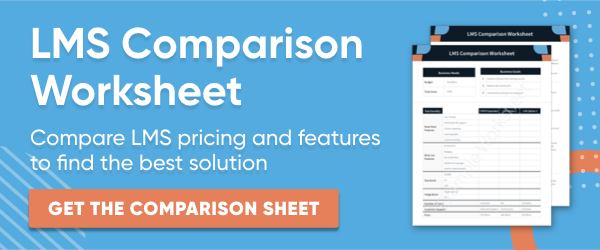Corporate learning management systems provide a number of benefits to an organization: centralizing and standardizing company training, controlling L&D costs, and streamlining and improving the effectiveness of employee learning and development.
However, as corporations grow and change, their learning and development needs will change as well. And LMS technology is transforming at lightning speed: from course-based, long-form content to adaptive, interactive and microlearning content that supports student engagement and business outcomes. Those shifts make it easy for existing software to become dated, difficult, and ineffective - especially for enterprises that rely on LMS technology to house and distribute training to a large, geographically diverse employee base.
So how do you know how outdated your current system is? When is it time to switch systems and update your technology to take advantage of new advancements and improve ROI?

Changing your corporate LMS is a major decision, affecting employees throughout the entire organization. And that means it’s not always the right time to switch systems, regardless of how old your technology is. If the disruption does more harm than good, your business could see better results from maintaining your current system.
That said, many companies are already unhappy with an existing LMS, with one survey¹ showing that almost 40% are looking to change or upgrade their current system. For those companies - and perhaps yours as well - it could be a good time to switch your LMS. To help you make a decision, we’ve compiled five key signs that your company is ready to upgrade and take advantage of new LMS technology.
Related Reading: What Big Businesses Need to Know about Switching LMS Systems
5 Signs Your Company Is Ready for a New Corporate LMS
1. Your Current LMS Provides a Poor Learning or Administrator Experience
User experience is one of the key indicators of the success of an LMS, impacting student engagement, course completion, and transferring of knowledge to job skills. User complaints – from learners or administrators – and declining satisfaction metrics are indicators that your LMS is not meeting your needs.
Satisfactory user experience comes from a straightforward and intuitive interface, well-designed and engaging content, and advanced features such as mobile learning, social learning, and gamification.
2. You’re Working Around Outdated Content and Features
The workforce has changed considerably over the last decade, and as the workforce becomes more digitally literate, learner expectations are changing. Static documents still have their place, but learners now expect – and respond to – more interactive content. Employees want to use their own device, learn on the go, and get more involved with features such as gamification and social learning.
Advanced content delivery and other features are necessary to connect with and engage learners. If you’re working around the features in your current system because it doesn’t support bring your own device (BYOD), bite-size microlearning, and interactive gamification to increase engagement, then you’re creating more work for your staff than is necessary. A newer LMS with updated features could save administrative time and help you engage employees more effectively.
3. Your LMS is Difficult to Integrate with Your Core Tech Stack
An LMS that is difficult to integrate with existing systems such as your CRM, email, or HR tools, means that you are missing out on valuable insights that can be used to improve learning outcomes throughout your business.
Even such a simple integration as Single Sign-On, so employees or contractors don’t have to log in to the LMS separately, can improve the overall user experience.
The ability to integrate new content to the LMS is critical as well. If your system does not support creating or purchasing content or lacks SCORM certification, an upgrade or change may be your best option.
Related Reading: What is SCORM?
4. Your LMS Doesn’t Align With Corporate Strategy
Every business should have a growth strategy and key performance indicators that it wants to improve. Employee engagement, employee retention, and productivity are just a few examples. Your LMS should align with business strategy, helping meet key objectives.
For example, if your organization is preparing to innovate to keep up with competitors and improve your market share, your learning management system should support that innovation. It should allow you to create and upload new content, integrate messaging changes, and report on how employees are progressing through the new materials. If that’s not possible, and your LMS isn’t supporting your business goals, then your existing LMS does not fit in with your corporate strategy and isn’t capable of getting the results your business needs.
5. Your Corporate LMS is Eating Up Your L&D or HR Budget
An outdated LMS system can be expensive, with a pricing structure that escalates costs for your business. The most common LMS pricing model, for example, includes per-user fees that can rapidly increase costs for businesses training large amounts of employees, contractors, or customers. Other systems include upgrade, support, and training charges that can eat into your budget.
For some businesses, those charges won’t make a significant difference. For others, they’re the difference between maintaining employee training and innovating to provide professional development that engages employees and encourages them to stay with the company. If your LMS system’s costs are hurting your ability to serve employees and align training with your corporate strategy, that’s a clear sign you’re ready for a new system.
Replacing Your LMS Should Improve Business Outcomes
If your training team, or users, have clear pain points with the existing LMS – such as poor user experience, or lack of content, integration or alignment with corporate strategy – it may be time to consider upgrading your LMS. As you research options for a new corporate LMS, keep in mind the features, integrations, and user experience that will make a new system a success.
Most importantly, look for a system that not only aligns with your business strategy but helps you improve key performance indicators. Not only will that help your business grow, but it will also position your training team as valued business enablers.
1. https://www.ispringsolutions.com/blog/how-to-choose-an-lms






